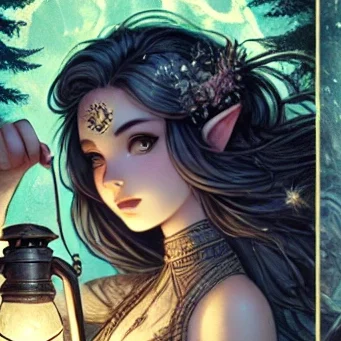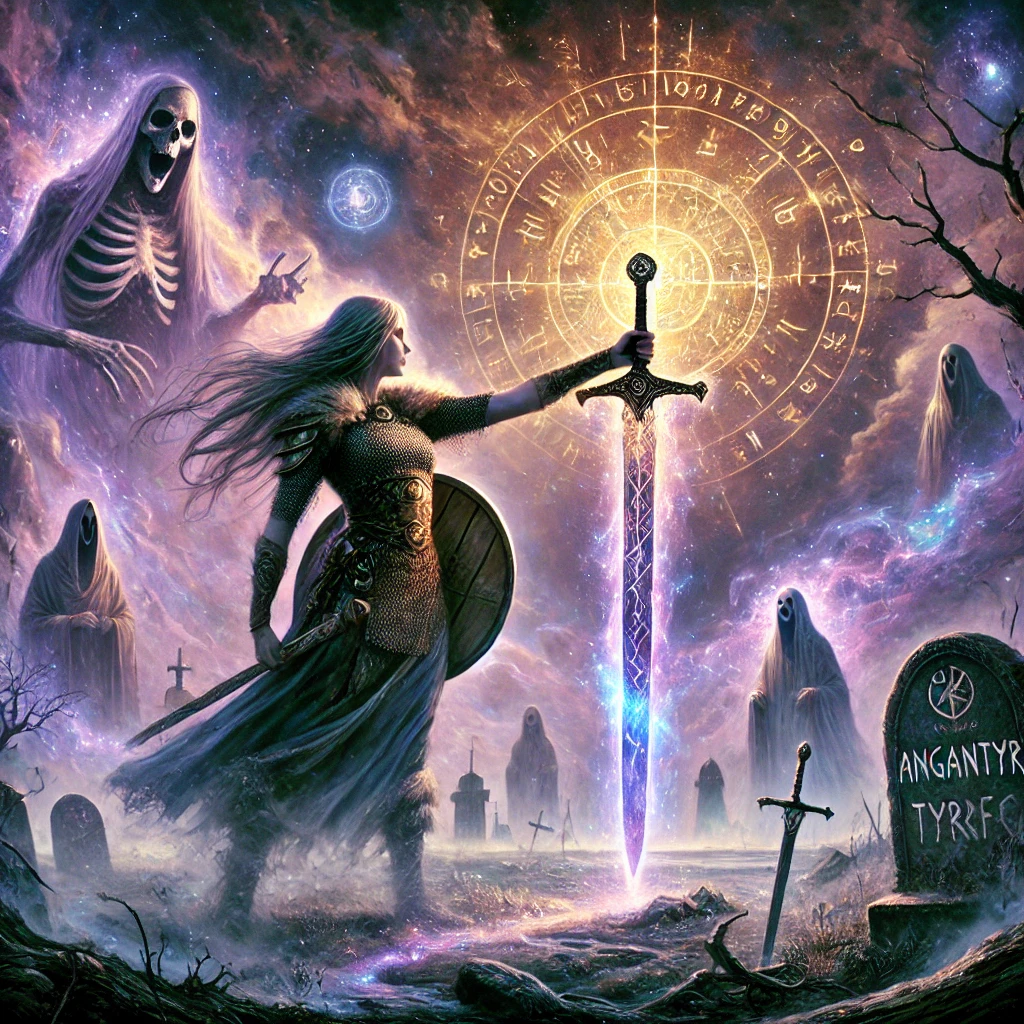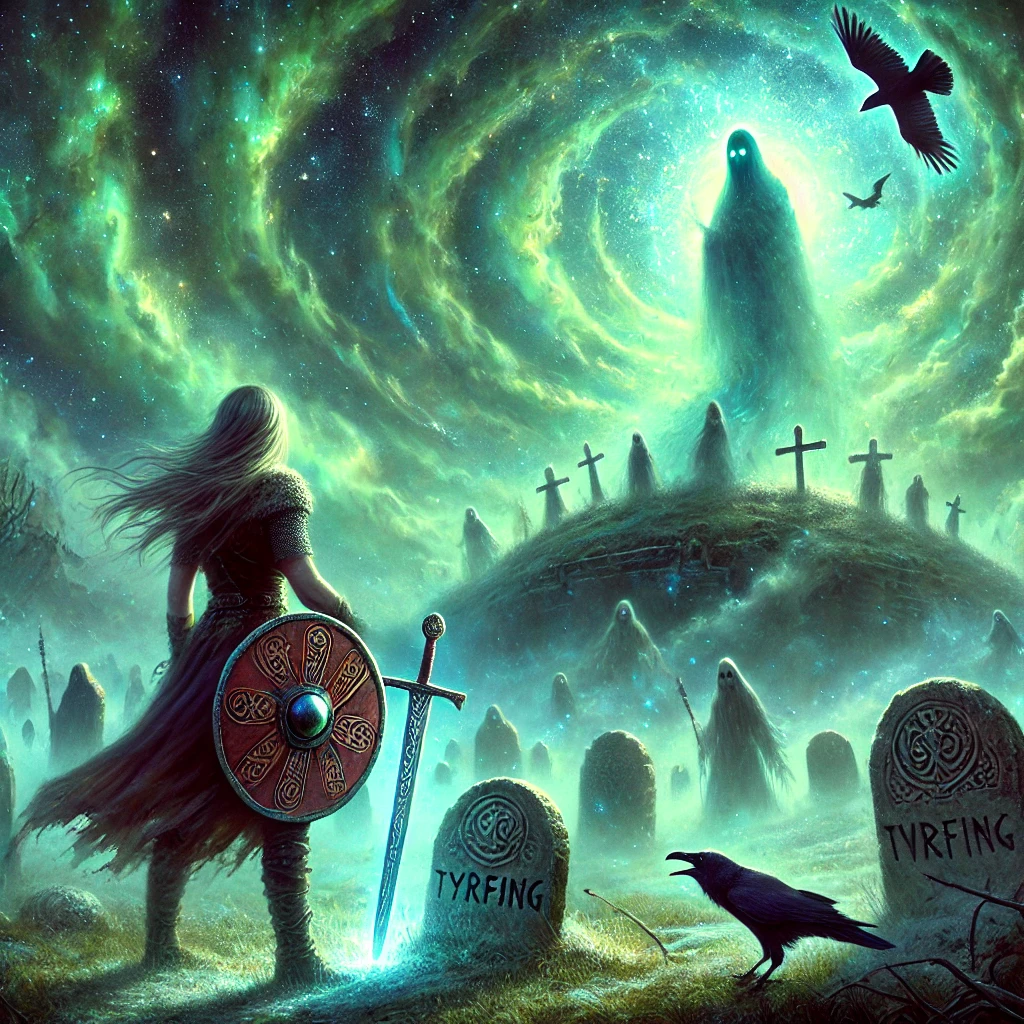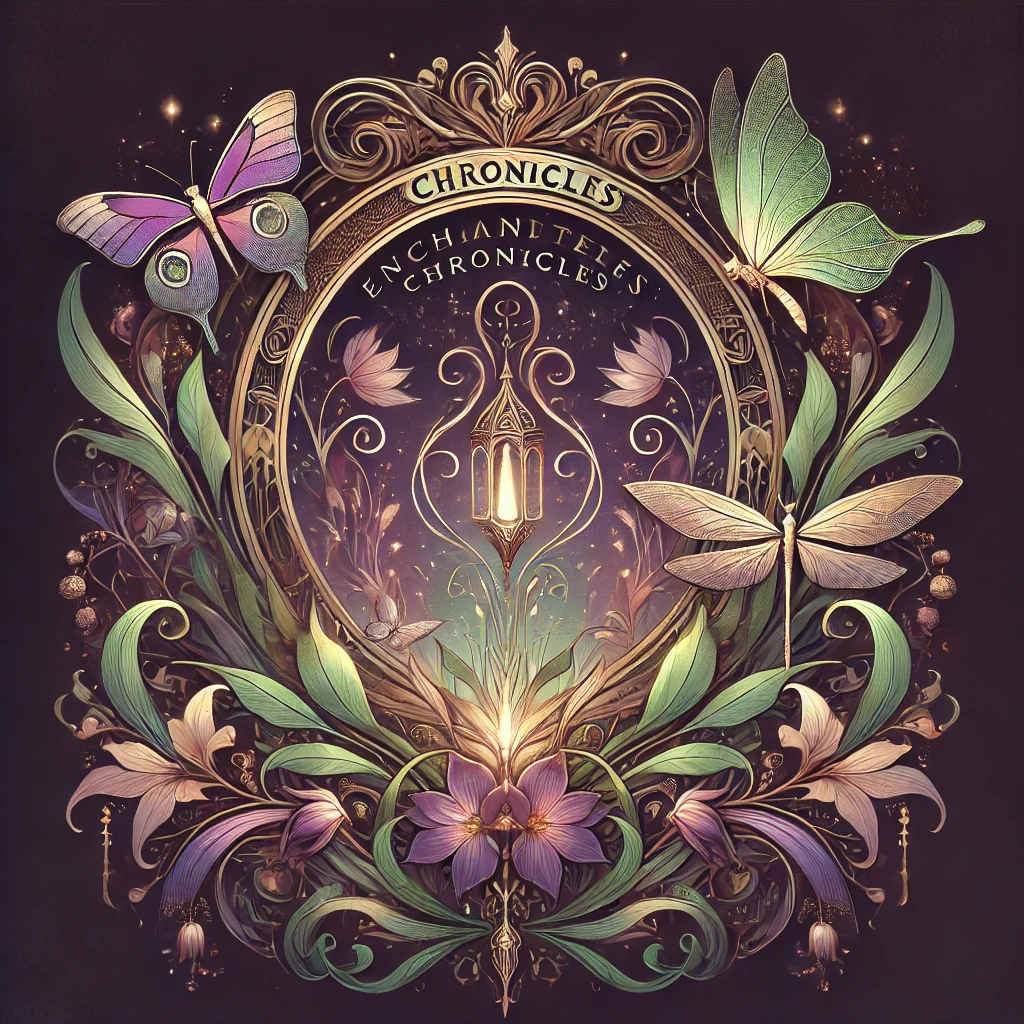The Origins of Tyrfing: A Weapon of Doom
In a world where fate is inescapable, one warrior dares to challenge it. Hervor, a fearless Viking shieldmaiden, defies death itself to claim Tyrfing, a Viking Legend about a sword of unmatched power—yet cursed to bring ruin to all who wield it. As she grips the blade forged by vengeful dwarves, she seals her destiny in blood and sorrow. A tale of courage, tragedy, and the heavy price of ambition, the legend of Hervor and the cursed sword Tyrfing continues to captivate hearts, echoing through the halls of Norse mythology.

By : Lirael Starwhisper

The origins of Tyrfing
The Origins of Tyrfing: A Weapon of Doom
Long ago, in the age of Viking kings and restless spirits, a blade of unmatched power was forged—a weapon destined to shape the fate of all who wielded it. This was Tyrfing, the accursed sword, whose origins lay in both divine craftsmanship and vengeful sorcery.
The legend begins with King Svafrlami, a mighty ruler and descendant of Odin himself. Seeking a weapon that could grant him absolute power, he captured two master dwarven smiths, Dvalin and Durin, and forced them to craft a sword of peerless sharpness and indestructibility. But dwarves are creatures of both craft and cunning, and in revenge for their enslavement, they laid upon the blade a terrible curse—Tyrfing would always kill when drawn, bring ruin to its owner’s family, and cause three great tragedies before its destruction.
Svafrlami met his end at the hands of a berserker named Arngrim, who claimed the sword and passed it down to his twelve sons, the most infamous of whom was Angantyr. A warrior of ferocious strength, Angantyr wielded Tyrfing in battle until he fell, along with his brothers, on the haunted island of Samsø.
But the saga did not end there. Angantyr’s daughter, Hervor, raised in secrecy, refused to be bound by fate or tradition. Dressed as a man, she set out alone to claim her father’s sword. Under a moonlit sky, she stood upon the burial mound, calling to the spirits of the dead. Fire erupted from the earth as Angantyr’s ghost appeared, warning her of Tyrfing’s cursed fate. But Hervor, fearless and unyielding, seized the sword despite the doom it promised.
Hervor: The Warrior Who Defied the Dead
Hervor was not an ordinary Viking woman, she inherited the spirit of a warrior from her father, Angantyr, a famed berserker who perished in battle while wielding Tyrfing. When she learned of her heritage, she refused to be bound by societal expectations. Dressed as a man and wielding weapons, she became a warrior of legendary skill.
Driven by destiny, Hervor embarked on a perilous journey to the haunted island of Samsø, where her father and his brothers lay buried. There, amidst a cursed battlefield where spirits roamed, she fearlessly called out to the dead, demanding that her father return Tyrfing to her.
As ghostly apparitions rose from the mist, Angantyr’s tormented soul warned her of the sword’s curse, urging her to leave it buried. Yet Hervor, undeterred by fear or fate, insisted on claiming her birthright. The grave burst into flames, and the sword, gleaming with an unnatural light, emerged from the depths of the earth.
She had won her prize—but at what cost?
Despite her father’s warnings, Hervor wielded Tyrfing with pride, proving her strength as a warrior. Yet the sword’s curse could not be denied. Though Hervor survived her battles, the doom of Tyrfing was not hers to escape forever.
She eventually bore a son, Heidrek, who inherited both the sword and its dark fate. In time, Tyrfing led to betrayal, murder, and war, fulfilling the prophecy that it would bring calamity upon its wielders.
Origins and Historical Context
The legend of Hervor and Tyrfing finds its roots in medieval Norse literature, primarily in the Hervarar saga ok Heiðreks, a saga written in the 13th century. This saga, though written down centuries after the Viking Age, preserves older oral traditions that were passed down through generations of Scandinavian storytellers.
Norse mythology and Viking legends were deeply intertwined with the beliefs and values of the time. The Vikings held a strong belief in fate (wyrd), the idea that destiny was predetermined and unavoidable. This concept is central to Hervor’s tale—despite her courage and strength, she cannot escape the doom that Tyrfing brings.
The saga also reflects the warrior culture of the Norse people, where battle prowess and honor were highly prized. Hervor, as a female warrior, stands out in a male-dominated society, highlighting the rare but significant presence of shieldmaidens in Viking lore.
Today, the legend of Hervor continues to captivate audiences, inspiring literature, art, and modern Viking reenactments. The themes of power, destiny, and tragedy remain as compelling as ever, proving that Norse mythology still resonates in contemporary culture.
A Tale That Endures
The legend of Hervor and Tyrfing has echoed through the centuries, preserved in medieval Norse texts like the Hervarar saga ok Heiðreks. The story resonates because it embodies timeless Viking themes—the thirst for glory, the inescapability of fate (wyrd), and the high cost of ambition.
Even today, Hervor’s story continues to inspire. As one of the most famous female warriors of Norse legend, she challenges traditional roles, proving that bravery and tragedy know no gender.
The Morality of the Legend
The tale of Hervor and Tyrfing forces us to reflect on the consequences of ambition and fate. Would you claim ultimate power if it meant bringing doom upon yourself and your loved ones? The Vikings believed in an unavoidable destiny, but Hervor defied it for the sake of honor and legacy.
Her story serves as a warning—sometimes, what we seek most may also be our undoing.
A Story of Power and Fate
The legend of Hervor and Tyrfing is more than just a tale of a warrior and a cursed sword—it is a story of unbreakable will, defiance of death, and the heavy cost of destiny. It reminds us why Norse mythology continues to captivate modern audiences, from literature to film and beyond.
For those drawn to the mystique of Viking sagas, Hervor’s legacy burns like the enchanted steel of Tyrfing itself—eternal, powerful, and tragic.

Click right here for other Stories…
Join our community of readers Subscribe To our newsletter!

Enchanted Chronicles: Ignite the Myths Within
Step into a world where ancient myths are no longer confined to books—they are part of your journey.
Sign up for free!
We won’t send you spam.
Unsubscribe at any time.
